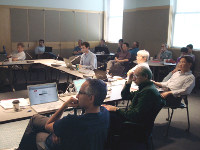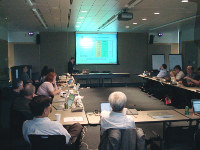 |
 |
|||||||||||||
|
|||||||||||||
|
|||||||||||||
|
From 25 to 26 June, about 40 attendees gathered at the Industrial and Labor Relations Conference Center at Cornell University in Ithaca, New York, to attend a workshop on the Cornell Electron Storage Ring Test Accelerator programme and to discuss R&D progress on the damping rings and electron clouds. It was the first dedicated workshop for interested and participating researchers, students, and physicists to talk about the state of the CesrTA project since its debut last year. With presenters from such research institutes as KEK, Argonne National Laboratory, INFN Frascati and others, the workshop's eight sessions addressed diverse aspects of electron cloud phenomena such as mitigation, simulation, emittance tuning and, most importantly, its relationship to the International Linear Collider. “We need to characterise the electron cloud phenomena enough to go beyond our own calculations and evaluate the limits it imposes on the ILC,” said David Rubin, professor of physics, Cornell University. In the ILC, scientists will collide beams of electrons and positrons travelling at nearly the speed of light with one-tenth the diameter of a human hair. Yet, this process is not as easy as it sounds! Superconducting wiggler magnets in the damping rings bring about intense synchrotron radiation of photons from the circulating particles. Scientists use this radiation to cool the particles and decrease the size of the bunches which are then accelerated to the collision point. In the damping rings, all the emitted photons do not immediately go away, but later end up colliding with the beam pipe. These photons knock electrons into the path of the positron beam which then accelerates them back to the beam pipe wall. The wall collisions give off more electrons until a large cloud forms that blocks the beam path and disperses the bunch. This is an issue which the CesrTA team takes very seriously. “We are one year into the CesrTA plan,” said Mark Palmer, CesrTA project manager, at Cornell University, “and the goal of this workshop is to make sure we have an efficient experimental plan for studying the electron cloud over the course of the next year.” To study this effectively, the CesrTA team is now planning 62 experimental shifts from 31 July through 8 September to conduct a detailed set of checks on the actual damping ring plans, such that when the ILC finally turns on, it will have the most precise beam possible. In addition, three more experimental runs are planned from late 2009 through mid-2010. The electron cloud that forms in the wigglers are of particular concern to the CesrTA scientists and the characterisation of the wiggler electron cloud is an important part of the R&D programme. The R&D programme includes tests of mitigation techniques, such as vacuum chambers with surfaces that inhibit emission of electrons and also the growth of the cloud. “The key focus of our research group is to study the electron cloud growth and its mitigation,” said Palmer, “and it's critical that we study the wigglers and dipoles because our simulations indicate those regions are the most important for the ILC damping ring design.” The first week of testing in the CesrTA "run" will involve a ring operation with a beam energy of 5 GeV. As a new feature, it will include tests with several newly installed vacuum chambers that have electron cloud mitigation technologies. This includes a chamber with a grooved surface that will be tested in a dipole magnet, a second grooved chamber for testing in a wiggler magnet, and a chamber with an amorphous carbon coating which will initially be tested in a drift region. The remainder of the CesrTA run will focus on measurements in the ultra-low emittance configuration at a beam energy of 2 GeV. The CesrTA team will be able to measure the instabilities and emittance growth induced by the electron clouds, by using new instrumentation capable of bunch-by-bunch measurements. “We need to spend a few shifts working on these things so we can get initial results with the new mitigation techniques and know where we need to go to follow-up on these studies,” said Palmer. The CesrTA team will measure emittance growth and instabilities for various bunch configurations at different beam energies to develop a very detailed picture of the effect of the electron cloud. “We hope to support long-term testing and provide critical inputs to the ILC damping ring engineering design,” said Palmer. -- Andre Sulluchuco |
|||||||||||||
| © International Linear Collider |

